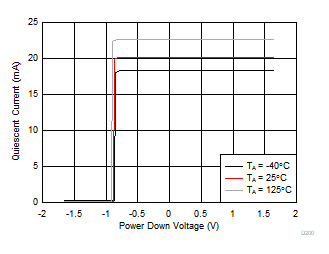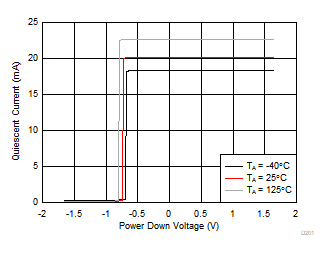JAJSKI4 February 2021 OPA858-Q1
PRODUCTION DATA
- 1 特長
- 2 アプリケーション
- 3 概要
- 4 Revision History
- 5 Pin Configuration and Functions
- 6 Specifications
- 7 Parameter Measurement Information
- 8 Detailed Description
- 9 Application and Implementation
- 10Power Supply Recommendations
- 11Layout
- 12Device and Documentation Support
- 13Mechanical, Packaging, and Orderable Information
8.4.2 Power-Down Mode
The OPA858-Q1 features a power-down mode to reduce the quiescent current to conserve power. Figure 6-23 and Figure 6-24 show the transient response of the OPA858-Q1 as the PD pin toggles between the disabled and enabled states.
The PD disable and enable threshold voltages are with reference to the negative supply. If the amplifier is configured with the positive supply at 3.3 V and the negative supply at ground, then the disable and enable threshold voltages are 0.65 V and 1.8 V, respectively. If the amplifier is configured with ±1.65 V supplies, then the threshold voltages are at –1 V and 0.15 V. If the amplifier is configured with ±2.5 V supplies, then the threshold voltages are at –1.85 V and –0.7 V.
Figure 8-9 shows the switching behavior of a typical amplifier as the PD pin is swept down from the enabled state to the disabled state. Similarly, Figure 8-10 shows the switching behavior of a typical amplifier as the PD pin is swept up from the disabled state to the enabled state. The small difference in the switching thresholds between the down sweep and the up sweep is caused by the hysteresis designed into the amplifier to increase immunity to noise on the PD pin.
 Figure 8-9 Switching
Threshold ( PD Pin Swept from High to Low)
Figure 8-9 Switching
Threshold ( PD Pin Swept from High to Low) Figure 8-10 Switching
Threshold ( PD Pin Swept from Low to High)
Figure 8-10 Switching
Threshold ( PD Pin Swept from Low to High)